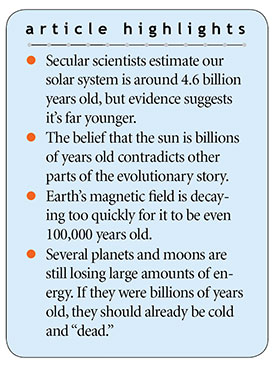 Secular astronomers insist our universe is 13.8 billion years old and our solar system is 4.6 billion years old. These claims contradict the Bible’s clear teaching of a recent six-day creation. In spite of the secular scientists’ claims, the enormous amount of data collected by unmanned space probes in the last half-century strongly confirms that the planets, moons, and comets in our solar system are quite young. Even when favorable old-universe assumptions are made, the data suggest that the maximum possible ages for these bodies are much, much younger than 4.6 billion years. And since these are maximum, not minimum, possible ages, the age estimates are consistent with a solar system that is just 6,000 years old. A number of evidences confirms this young age.
Secular astronomers insist our universe is 13.8 billion years old and our solar system is 4.6 billion years old. These claims contradict the Bible’s clear teaching of a recent six-day creation. In spite of the secular scientists’ claims, the enormous amount of data collected by unmanned space probes in the last half-century strongly confirms that the planets, moons, and comets in our solar system are quite young. Even when favorable old-universe assumptions are made, the data suggest that the maximum possible ages for these bodies are much, much younger than 4.6 billion years. And since these are maximum, not minimum, possible ages, the age estimates are consistent with a solar system that is just 6,000 years old. A number of evidences confirms this young age.
The enormous amount of data collected by space probes in the last half-century strongly confirms that the planets, moons, and comets in our solar system are quite young. ![]()
A Young Sun
As the sun “burns” its nuclear fuel, its composition gradually changes. Secular scientists believe it would have been much dimmer billions of years ago than it is today. Because of this, Earth would have received much less sunlight and been so cold it would have frozen. Although occasional reports claim this “faint young sun paradox” has been solved, the purported solutions can’t withstand scrutiny.1 Of course, this problem disappears if the sun was recently created in its current state without having to go through billions of years of change before Earth was habitable. Interestingly, famed solar astronomer John Eddy once acknowledged that observational data of the sun do not demand an age of billions of years and scientists could “live with” an age of just 6,000 years for the earth and sun.2
Planetary Magnetism
Secular scientists have enormous difficulties explaining the continued existence of Earth’s magnetic field. Such fields are caused by moving electrical charges, such as current flowing down a wire. Powerful currents in Earth’s core drive our planet’s magnetic field. However, energy losses in an electrical circuit cause currents to “run down” over time. The currents inside Earth are no exception. For this reason, its magnetic field should have disappeared long ago if it were billions of years old. Cal Tech geophysicist David Stevenson stated:
We do not understand how the Earth’s magnetic field has lasted for billions of years. We know that the Earth has had a magnetic field for most of its history. We don’t know how the Earth did that….We have less of an understanding now than we thought we had a decade ago.3
Based on historical measurements, Earth’s magnetic field is losing half its energy every 1,400 years or so. Given this rate of loss, the field’s energy would have been so great just a few tens of thousands of years ago that it would have melted the planet’s crust.4 Earth’s magnetic field must be young.
And it’s not just Earth’s field that points to a youthful age for the solar system. Physicists use a quantity called the magnetic dipole moment to indicate the strength of the biggest part of a planetary magnetic field. Secular scientists were surprised when spacecraft observations showed that Mercury, Neptune, and Uranus all had magnetic dipole moments larger than expected based on secular long-age assumptions. In fact, Mercury’s magnetic field wasn’t supposed to exist at all.5,6 Likewise, the magnetic field of Jupiter’s moon Ganymede should not still exist if it is billions of years old.7
However, using biblical, young-universe assumptions, creation physicist Russell Humphreys made multiple successful predictions about the magnetism of bodies in our solar system. He correctly estimated the magnetic dipole moments of Uranus and Neptune years before they were actually measured.5,8 He also successfully predicted a significant decrease in Mercury’s magnetic dipole moment between 1975 and 2011, a decrease that surprised secular scientists, although he underestimated the size of the decrease (8% as opposed to his predicted 4-6%).9, 10

0 Comments